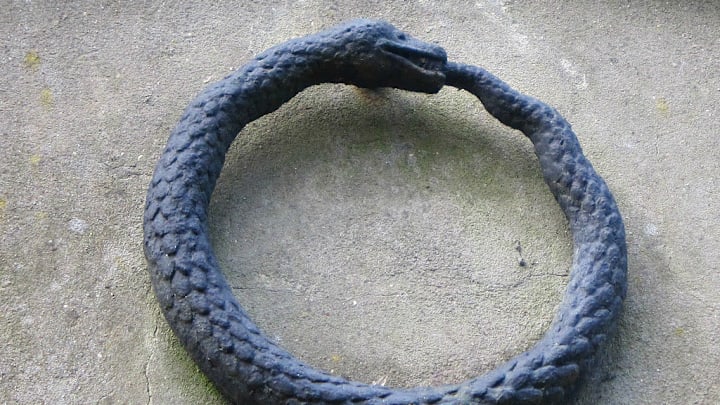The ouroboros is an ancient symbol of a serpent consuming its own tail, seen across multiple cultures and time periods. Its circularity represents eternity and the cycle of birth, life, and death, while the word ouroboros (pronounced aw-ro-BAW-roz) comes from Greek and means “devouring [its] tail.” It was often prefixed by the word drákōn, which can be interpreted as either “serpent” or “dragon,” and so visual representations of the ouroboros have also changed between the two.
Depictions of the symbol have been found in ancient Egypt dating to around 1300 BCE, with the earliest known inscription of an ouroboros discovered on a gold shrine in Tutankhamun’s tomb.

In King Tut’s world, the ouroboros was linked to the annual flooding of the Nile that brought essential water to the crops alongside the river before receding. It was also associated with the daily passage of the sun across the sky. The Egyptians believed the sun god Ra (or Re) carried the sun on his barge across the sky each day before being consumed by his mother, Nut, every evening, and then being reborn the next day. This circularity was represented by the symbol of the serpent consuming its own tail in a never-ending cycle and it was used to adorn many tombs and monuments across ancient Egypt.
Egypt was not the only place where the ouroboros had mythological power. Representations of the ouroboros reflect the Norse concept of the cosmos. An enormous serpent named Jörmungandr was said to encircle the entire world, symbolizing the infinite loop of creation and destruction. The serpent is both terrible and protective at once, representing the duality of the human condition and the idea that from every ending comes a new beginning.
Similarly, in Hindu mythology, the great serpent Shesha is coiled around the cosmos. Shesha existed before the universe was created and will exist beyond its destruction, the myths contend, signifying the endless loop of existence. In these two mythologies the ouroboros encourages a circular, rather than linear, conception of time.
Allusions in Alchemy
Alchemists in the Hellenistic world adopted the symbol from ancient Egypt. A diagram of a black and white ouroboros appears in an ancient scroll called Cleopatra’s Chrysopoeia (chrysopoeia means “gold-making”). This Cleopatra was not the same as the queen of Egypt who died in 30 BCE, but a leading alchemist in Alexandria during the 3rd century CE. Cleopatra’s Chrysopoeia has been described by historians as one of the earliest science books authored by a woman, and it contains philosophical musings alongside alchemical experiments for turning common metals into gold. In this and other alchemical books, the ouroboros was used to represent eternity, shifting its meaning away from the original Egyptian link to the cycles of the Nile and the sun, and toward its more modern connotations.

Renaissance alchemists adapted the ouroboros to their quest for the magnum opus, or “great work,” such as securing immortality or transforming lead into gold, achieved through practical experiments and philosophical debates. German engraver Lucas Jennis included an iconic image of an ouroboros in his 1625 work De Lapide Philosophico, depicting it as a wyvern (a mythical winged reptile) or dragon consuming its own tail.
The book contains 15 emblems that communicate the philosophical underpinnings of alchemy. The first five engravings show different versions of two competing impulses thought to be at work inside all people, for example a wild wolf and a tamed dog fighting. This concept is followed by the depiction of the ouroboros representing the sublimation of these impulses.
Balancing the Human and Divine
From the 2nd century CE, Greco-Roman Gnostics used the ouroboros to symbolize the tension between the divine and earthly aspects of humankind. And for them, the image of the serpent eating its own tale represents how these two sides can be balanced and unified. Gnostics believed that humans each held a tiny part of God, often represented as a divine spark, inside themselves. This reading equates the snake with humanity and represents the contrary forces of the divine and the human that find harmony in the ouroboros.

The ouroboros maintained its links to psychology well into the modern era. German chemist August Kekulé identified the ring-shaped structure of the compound benzene after dreaming of a serpent consuming its own tail in 1865. Psychiatrist Carl Jung conceptualized it as an archetype of human character in which we constantly seek to consume ourselves and be reborn.
The enduring symbolism of the ouroboros has ensured its longevity. It is found in a wide variety of visual arts, from the 19th-century funerary monument of Archduchess Maria Christina of Austria to artist Salvador Dali’s 1976 artist’s book Alchimie des Philosophes, which features an ouroboros cut into many pieces but maintaining its circularity.
Today the ouroboros is a popular choice as a tattoo, perhaps alluding to the multiple meanings that people find in this ancient symbol. It reminds us of the endless cycle of life and death—and the possibility of rebirth.
Discover More Stories About Mythical Creatures:
